The Most Effective Exercises for Treating Patella Tendinopathy
We list out a few of our favourite exercises that we commonly give for the condition of Patellar tendinopathy.
Patellar tendinopathy
Patellar tendinopathy is a common overuse injury that affects the patellar tendon, which connects your knee cap (patella) to your shin bone (tibia).
Patellar tendinopathy, also known as ‘jumpers knee,’ is a prevalent condition caused by overuse of the patellar tendon.
Management of Patella Tendinopathy
The mainstay of management is activity modification and progressive strengthening.
Hands-on treatment, specifically involving the release of the;
- quads
- calves
- glutes
- lower back
It is important to look at the body as a whole in regard to the deep cause of the injury development. This is particularly important in people who have developed tendinopathy on one side as opposed to both legs – as there must be a cause for the loading to be more on one side of the body than the other (as we make as many steps with each leg!)
Example of a cause of Patella Tendinopathy
An example of causes may be something as simple as a mum who always holds the baby on one arm. This difference in loading (particularly when the child starts getting heavier and heavier) can have a noticeable effect on how her pelvis stabilises.
This is both with the child on the hip and when it is not.
This can create important imbalances that affect the leg.
Assessing if someone has patella tendinopathy
An example of some of the functional tasks we will complete in a standard assessment of patella tendinopathy.
We are looking for;
- balance
- comfort weight bearing
- movement pattern of the hip
- movement of knee
- movement of ankle
- what the client does with their upper body
It is important to look at the movement patterns in different angles as sometimes a deficiency can be very subtle, and have a big impact on where the assessment plan for the client goes.
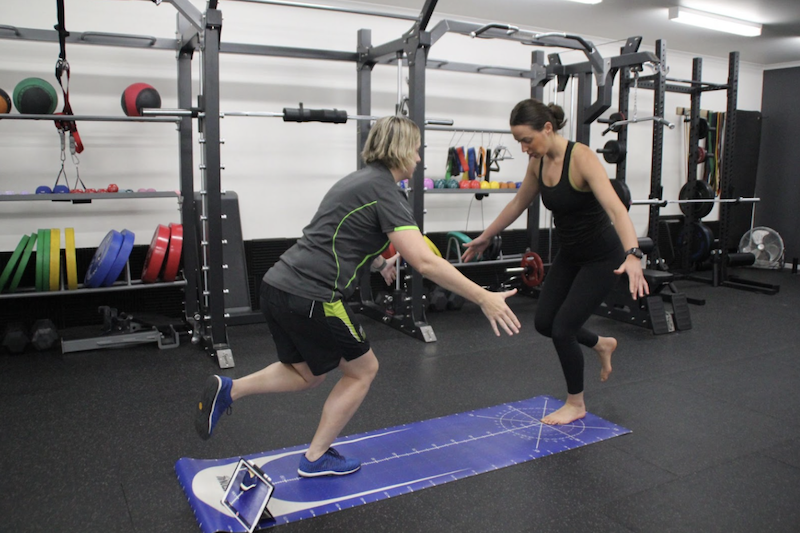
The Best Exercises for Patella Tendinopathy
A one size fits all approach should not be used for Patella Tendinopathy, however, I did want to go through a few of our favourite exercises that we commonly give for this condition – our disclaimer as always, is to get things checked first by your healthcare professional.
ISOMETRIC HOLDS
As with all tendinopathies, it is best to start with isometric (holds) exercises in the short term, as these will generally produce minimal pain.
A great exercise to start with is wall sits:
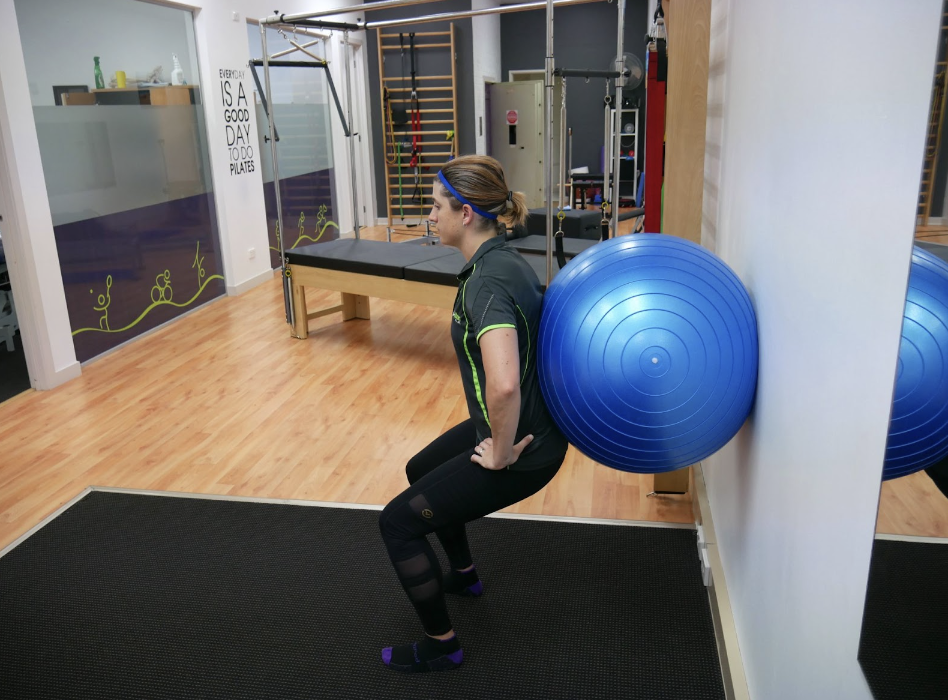
Isometric Holds
To complete this exercise;
- Stand with your back against a wall
- Your feet about shoulder-width apart
- Slowly slide down the wall until your knees are bent at a 90-degree angle
- Then hold for 30-60 seconds
- Then slowly standing back up.
- Repeat this exercise for 3-4 sets, depending on your pain levels
It is proven that isometric exercises (which is long holds – such as a wall sit), can assist by reducing pain whilst doing the exercise.
The reduction in pain has positive effects on the brain (its’ anticipation of pain occurring – in a feed forward mechanism) and how much pain is experienced in general.
ECCENTRIC SQUATS
Another great exercise is Eccentric Squats
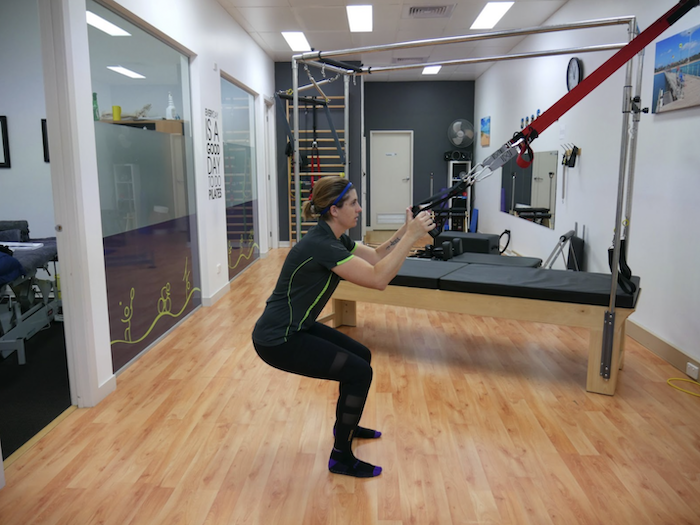
Eccentric squats
Eccentric squats are a great exercise for people with patellar tendinopathy, once the pain has reduced with movement, and you are able to complete 4 by 30-60 sec wall sits.
This version here is utilizing a suspension machine – you may need to start with this to enable higher reps and to be sure not to cause pain.
The main points of importance with this exercise are to;
- initially remain weight-bearing through the heels – which is likely to load the glutes as well as the quads.
- Keeping your centre of mass backwards, it also means there is less forward translation loading of the patella tendon
- If you can tolerate, you can load with some weights as you slowly lower into a squat position (obviously you will have progressed beyond the suspension machine by this stage).
- We recommend commencing with 3 sets of 8-12
- Then as you get stronger, build to 4-6 sets of 4 (heavy load).
CALF RAISES
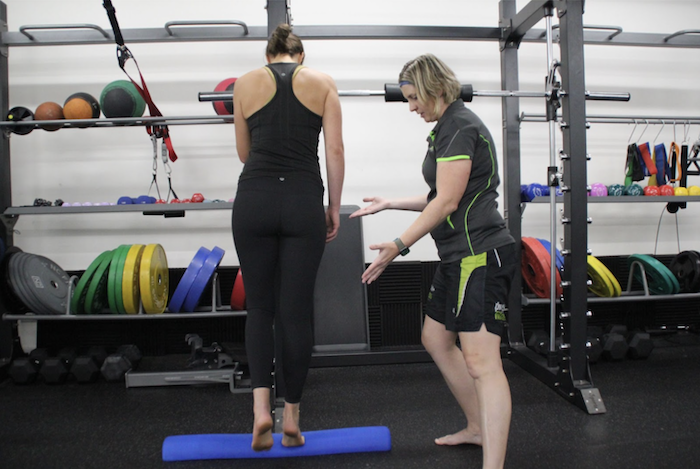
Calf raises
Calf raises can assist, in particular, gastrocnemius (the calf that activates with a straight knee) due to its attachment point in the femur.
To perform this exercise;
- Stand on a step or platform with your heels hanging off the edge
- Slowly raise up onto your toes
- Then slowly lower back down
- Commence with 3 sets of 12
- Make sure to keep your knees straight throughout the movement
- You may need to commence on double legs and progress to single legs
REHAB TIPS FOR PATELLAR TENDINOPATHY
Remember, it’s important to stay consistent with your exercises if you’re dealing with patellar tendinopathy.
The frequency of exercises depends on your phase of rehab and how quickly your pain subsides.
Yes, you may have to reduce or pause your running to allow the tendon to improve quickly – this is only done as a last resort as we know all runners just want to run!
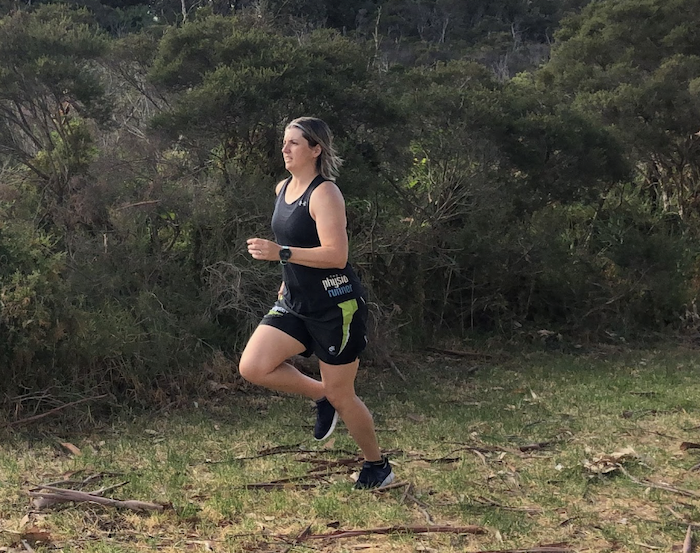
PATELLAR TENDINOPATHY FAQS
WHAT IS PATELLAR TENDINOPATHY?
Patellar tendinopathy, also known as ‘jumpers knee,’ is a prevalent condition caused by overuse of the patellar tendon.
This tendon connects the kneecap to the shinbone and can be affected by activities that involve frequent jumping and running, such as;
- volleyball
- tennis
- football
- badminton
It is important to note that this injury commonly occurs in individuals participating in these sports.
Patellar tendinopathy is often characterized by several common symptoms. These symptoms can include morning stiffness (especially when descending stairs), tenderness over the patellar tendon (which can be felt as discomfort or pain when pressure is applied below the kneecap), and variable levels of pain.
It is important to note that while the pain may decrease during exercise, it can worsen after periods of rest. In some cases, individuals may experience severe pain that inhibits their ability to participate in sports or physical activities.
HOW DO YOU FIX PATELLAR TENDINOPATHY?
The treatment plan for patellar tendinopathy encompasses various methods to alleviate pain and promote healing.
These may include;
- Using ice
- Taking simple painkillers like paracetamol or anti-inflammatories such as ibuprofen
- Practicing relative rest
- Engaging in muscle strengthening exercises
- Following an eccentric exercise program
- Undergoing physiotherapy which may involve manual techniques or specific exercises
- Managing one’s weight is crucial
- Cross-training activities like swimming, spin classes, Pilates, circuits, gym equipment usage, rowing and weight training are recommended.
- Alternative sports such as cycling can also be beneficial.
- Further interventions may include podiatry assessment for shoe inserts
- Possibly high volume injections of saline and anaesthetic into the tendon,
- dry needling treatment,
- GTN patches application
- Surgery if necessary
HOW DO YOU TREAT TENDINOPATHY IN THE KNEE?
Management of injuries involves modifying activities and gradually strengthening the affected areas.
Hands-on treatment, such as releasing tension in the;
- quadriceps
- calves
- glutes
- lower back
It is crucial to consider the body as a whole when determining the underlying cause of injury development.
This becomes especially important for individuals who have developed tendinopathy on one side of their body rather than both legs since there must be a reason for uneven loading between sides (as we take steps with each leg).
DOES PATELLAR TENDINOPATHY EVER HEAL?
The process of returning to your sport after an injury is highly dependent on your symptoms and the nature of the sport you participate in.
It is crucial to adopt a gradual approach when reintegrating yourself into physical activity. This is because you may have experienced a decline in fitness levels.
Therefore, engaging in cross-training activities like swimming and cycling can help maintain your overall fitness while allowing for a smoother transition back into your primary sport.
It is widely believed that tendinopathy often arises from overuse and improper training techniques. When resuming training for your sport, it can be beneficial to incorporate variations in terms of speed, distance, and duration.
By doing so, you enable your tendon to adapt gradually to different loads placed upon it, minimizing the risk of further injury. If your goal involves increasing running distance or time, experts recommend implementing a gradual approach by increasing these parameters by approximately 10% per week.
This incremental progression helps prevent excessive strain on the tendon and reduces the likelihood of re-injury. Remember that prioritising proper recovery methods and seeking guidance from healthcare professionals will significantly contribute to achieving a successful return to sports without compromising long-term health outcomes.
WHAT ARE SOME CAUSES OF PATELLAR TENDINOPATHY?
Although the exact cause of patellar tendinopathy is not fully understood, it is believed to be an overuse injury that occurs when a tendon cannot adequately adapt to the strain placed on it. This results in repeated microscopic damage within the tendon fibres.
As the tendon attempts to heal itself, it can become painful and thickened. It is important to note that terms such as patellar tendinitis or tendinosis are often used interchangeably with tendinopathy, referring to the same condition.
Tendinopathy can develop in one leg rather than both legs due to an imbalance caused by specific factors. One example of a potential cause is when a mother frequently carries her baby on one arm. This uneven loading, especially as the child grows heavier over time, can have a significant impact on the stability of her pelvis, both while carrying the child and during other activities.
These imbalances can lead to important muscle imbalances that ultimately affect the leg. It’s crucial to be aware of these potential causes and strive for balance in order to prevent tendinopathy from developing asymmetrically.
PATELLAR TENDINOPATHY RECOVERY TIME
By following the eccentric exercise program, you can potentially eliminate any pain and safely resume your participation in sports.
This program is specifically designed to gradually increase the strain on your tendon in a controlled manner. It consists of three stages that aim to improve your symptoms over a period of 3 to 6 months, although results may be seen sooner in some cases.
The key is to stick with the program and trust the process for long-term relief and optimal recovery.
Returning to running after an injury is generally safe as long as you experience minimal discomfort.
However, it is typically advised to abstain from running for at least one month to ensure proper rehabilitation and prevent any potential aggravation of pain. This precautionary period allows your body ample time to heal and recover fully before gradually reintroducing the physical stress of running.
By following this recommendation, you can minimise the risk of further harm and promote a smoother recovery process.
PATELLAR TENDONITIS VS PATELLAR TENDINOPATHY, WHAT ARE THE DIFFERENCES?
The terms tendinopathy and tendonitis are often used interchangeably, but they actually refer to different conditions, although they share similar symptoms. Tendinopathy is a condition that involves the degeneration of the collagen protein in tendons.
It is a broad term that encompasses various problems related to tendons, such as tendonitis, tendinosis, tears in the tendon, and inflammation of membranes surrounding a tendon. On the other hand, tendonitis specifically refers to inflammation of the tendon itself.
HOW DO YOU REHAB PATELLAR TENDINOPATHY?
When conducting a standard assessment of patellar tendinopathy, it is essential to focus on functional tasks such as balance, weight-bearing comfort, and movement patterns of the hip, knee, ankle, and upper body.
It is crucial to examine these movement patterns from different angles as even subtle deficiencies can have a significant impact on determining the appropriate plan for the client’s treatment. By thoroughly assessing all aspects of movements, it can be ensured that any underlying issues that may be contributing to their condition are addressed.
Patellar tendinopathy is a condition that requires individualized treatment rather than a one-size-fits-all approach.
When dealing with tendinopathies, it’s generally recommended to begin with isometric exercises (holds) in the short term, as these typically result in minimal pain. However, before starting any exercise regimen, it’s crucial to consult with a healthcare professional for proper evaluation and guidance.
Some examples of exercises commonly prescribed for patellar tendinopathy include;
- wall sits
- eccentric squats
- calf raises
These exercises can be beneficial for managing the condition but should only be performed under the guidance and supervision of a qualified professional after obtaining appropriate medical advice.
xxxxxxxx
Patellar tendinopathy, commonly referred to as ‘jumpers knee,’ is a prevalent condition that arises from repeated stress on the patellar tendon.
This specific tendon connects the kneecap to the shinbone and can become affected due to activities that involve frequent jumping and running, such as volleyball, tennis, football, and badminton.
It is important to note that this soft injury is frequently encountered in individuals actively participating in these sports.
Treating patellar tendinopathy requires an individualised approach rather than a one-size-fits-all solution. When addressing tendinopathies, it is generally recommended to commence with isometric exercises (holds) in the short term as they often result in minimal pain.
However, before embarking on any exercise regimen or treatment plan, it’s crucial for individuals to seek proper evaluation and guidance from healthcare professionals who specialise in this field.
They will be able to provide personalised recommendations tailored specifically towards each patient’s unique circumstances for optimal healing outcomes.
Consistency is key when it comes to dealing with patellar tendinopathy. The frequency of your exercises will depend on the phase of your rehabilitation and how quickly your pain subsides. While it may be necessary to reduce or pause your running temporarily in order for the tendon to heal effectively, this should only be considered as a last resort.
We understand that all you want to do is get back out on the road, so working together to find a balance that allows for both recovery and progress in your training regimen is essential.
Written by Morgan Deegan
B Sc (Physiotherapy) – Curtin University
Post Grad Certificate in Sports Physiotherapy – LaTrobe University
Morgan Deegan is a passionate Physiotherapist and Director of Physio and Fitness Clinic. She focuses on treating each client with an individual, goal oriented approach. She is an expert at looking at the body holistically and ensuring that each step of the process to recover is managed and thoroughly understood by the client.

